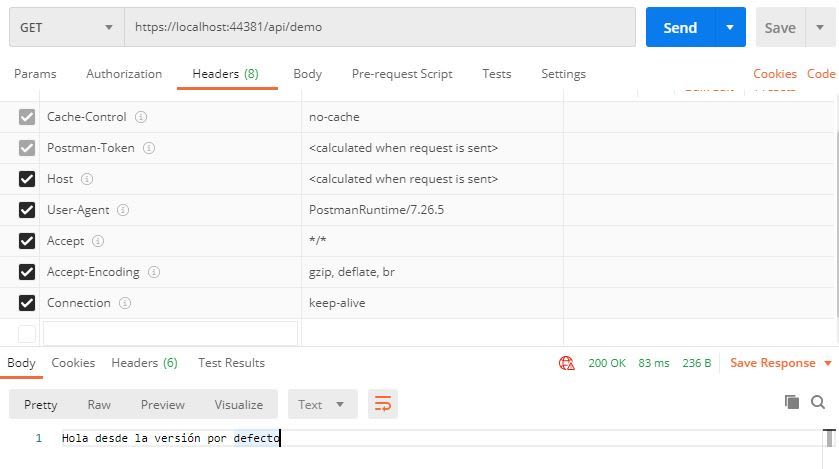40
Versioning your API in .NET Core
Hi,
Sometimes we need to change the behavior or payload of our APIs. For these cases it is recommended to have a versioning API.
If your API is used by your websites, this is not a big problem because you can change these websites according the new requirements of our APIs.
On the other hand, if the API is consumed by mobile apps or third-party applications, its more complicated because you need release a new version of your apps and the users must install this new version in their mobile phones. So, in order to prevent errors and avoid breaking changes, it is important to have a versioning of your APIs.
In order to versioning your API in .NET Core, you need to do the following steps:
Install-Package Microsoft.AspNetCore.Mvc.Versioningstartup.cs, put the following code:
services.AddApiVersioning(x =>
{
x.DefaultApiVersion = new ApiVersion(1, 0);
x.AssumeDefaultVersionWhenUnspecified = true;
x.ReportApiVersions = true;
x.ApiVersionReader = new HeaderApiVersionReader("x-api-version");
});Where:
x.DefaultApiVersion -> indicates the default version of the API.x.AssumeDefaultVersionWhenUnspecified-> indicates if the default version of the API will be used if in the request header we don't indicate the version of the API.x.ReportApiVersions -> indicates if we want to show in the response the available versions of the API.x.ApiVersionReader -> indicates how we are going to send the API version in the request.In our case, we will send the version of our API through the Header, in this way, we avoid that the applications that use the API do not have to modify their calls. In addition, we add more security because we will send the version by header instead of querystring
In order to add the versioning to your controllers, you only need to add the following decorator in your class
[ApiVersion("X.0")], where X.0 will be the version number of your API for this class. In case your controller does not have this decorator, the API version for this class will be the default version (in our case "1.0").Controller without versioning
[Route("api/[controller]")]
[ApiController]
public class DemoController : ControllerBase
{
[HttpGet]
public IActionResult GetDemo()
{
return Content("Hola desde la versión por defecto");
}
}Controller with versioning
[Route("api/[controller]")]
[ApiController]
[ApiVersion("2.0")]
public class DemoController : ControllerBase
{
[HttpGet]
public IActionResult GetDemo()
{
return Content("Hola desde la versión 2");
}
}By default, the API will call the endpoint of the controller without specified version.

The API will call the endpoint of the controller without specified version again, because we set the default version of the API equals to 1.0

In this case, the API will return a different response because it goes to the controller that has this version.

If the API is called with a version that does not exist, it will return "by default" a BadRequest (400) indicating that it does not support this version number

In addition, the API will inform you of the available versions that you can use, because we set the value of
ReportApiVersions = true in the configuration.
Finally, we already have our versioned api. You can find the github repository in this link:
See you next time!
40
